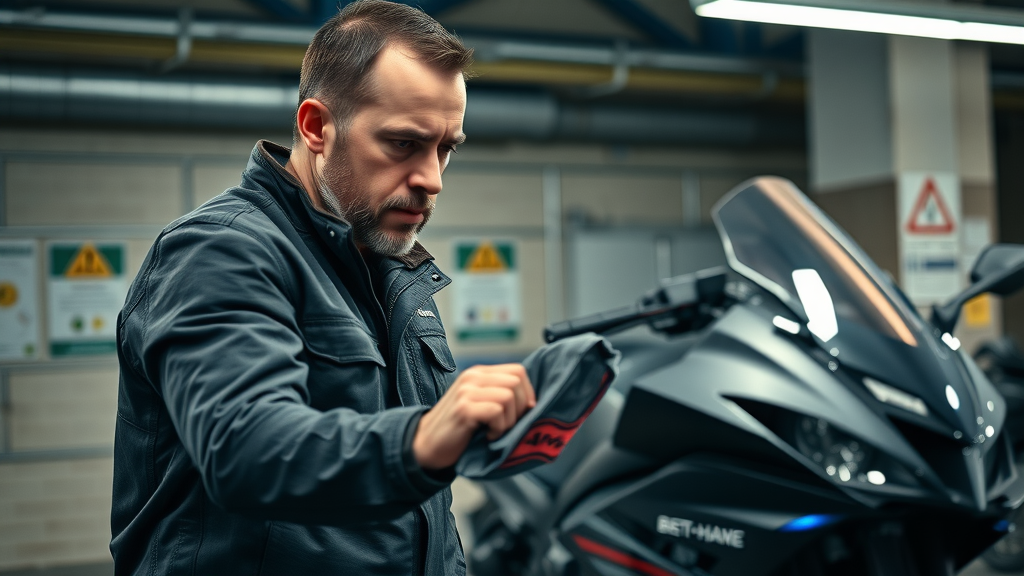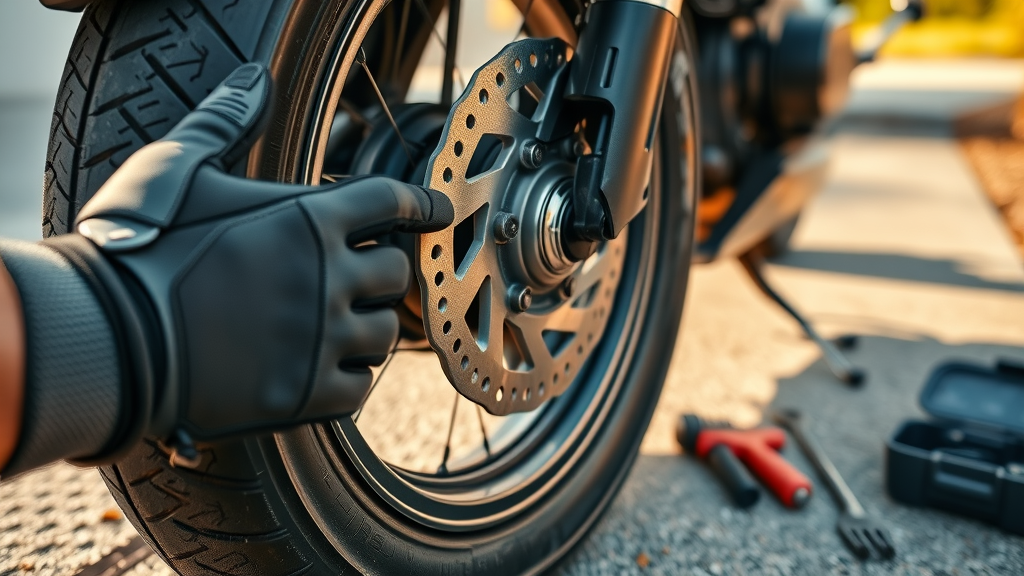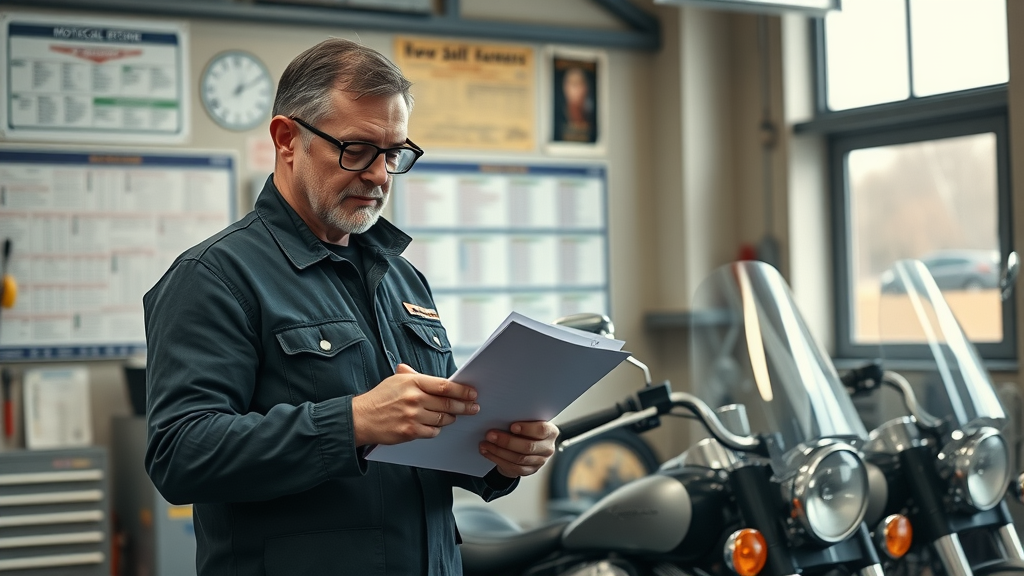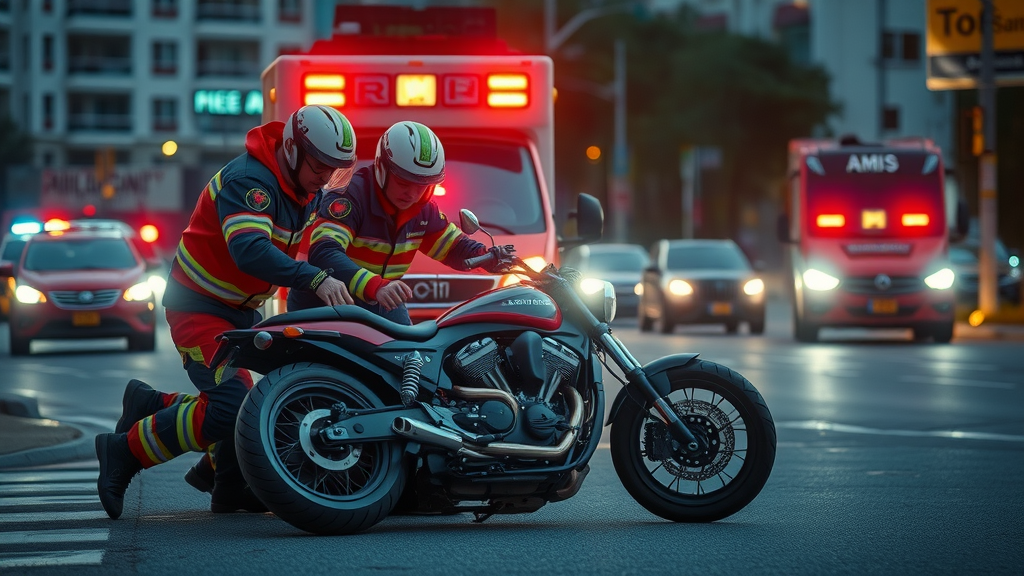Did you know that nearly one-third of fatal motorcycle accidents result from mechanical failures or improper maintenance ? This eye-opening fact highlights just how critical regular motorcycle safety checks are for every rider. Whether you’re a seasoned enthusiast or gearing up for your first trip, neglecting pre-ride inspections can turn a simple oversight into a life-or-death scenario. In this comprehensive guide, you’ll discover the lifesaving steps and expert advice you need to ride with confidence and avoid becoming another statistic.
Why Motorcycle Safety Checks Are Critical: A Look at the Numbers
The importance of motorcycle safety checks is impossible to overstate when you examine the numbers. According to recent studies by the National Highway Traffic Safety Administration, a significant portion of motorcycle accidents stem not from rider error but from mechanical failures. Many of these tragic incidents could have been easily prevented with routine safety checks, proper maintenance, and a critical eye for detail before every ride. In fact, skipping even a simple safety check can leave you vulnerable to hazards hiding in plain sight.
A pre-ride safety inspection acts as your first line of defense against unexpected malfunctions—from brake lamp failures to tire blowouts. Performing these checks consistently not only ensures personal safety but also keeps you compliant with inspection regulations implemented to protect all road users. Many motorcycle riders underestimate the power of a quick ride inspection and how it can directly prevent tragedies. The following section covers what you must inspect and why every point on the safety checklist matters for your well-being—and potentially for your life.
"According to the National Highway Traffic Safety Administration, nearly one-third of fatal motorcycle accidents are caused by mechanical failures or improper maintenance—regular motorcycle safety checks can be the difference between life and death."

Understanding Motorcycle Safety Checks: Essential Pre-Ride Inspection Steps
Every effective motorcycle safety check starts before you even roll out of the garage. Regular, methodical inspections are crucial for identifying risks and avoiding motorcycle accident situations resulting from overlooked issues. This section covers the safety checklist items recommended by safety foundations and outlined in your owner’s handbook, ensuring nothing critical slips through the cracks.
The core pre-ride safety inspection covers several vital areas. For starters, always assess tire pressure and tread depth to prevent loss of grip and unexpected blowouts. Next, ensure your brakes are in top shape by testing both front and rear for stiffness, odd noises, or a “spongy” feel. Light and signal inspections follow, since functioning headlights, brake lamps, and turn signals are mandatory for night and day riding. With fluid levels, don’t forget to check engine oil, coolant, and brake fluid, as low or contaminated fluids can lead to catastrophic engine or brake failures. Lastly, inspect your chain or belt for slack and wear—neglecting this simple step leads to loss of power or control mid-ride.
- Tire pressure and tread assessment
- Brakes functionality check
- Light and signal inspection
- Fluid levels review
- Chain and belt condition
- Suspension system inspection
- Mirrors and handlebars adjustment
| Motorcycle Safety Check Item | Why It Matters | Frequency |
|---|---|---|
| Tires | Ensures optimal grip and stability | Before Every Ride |
| Brakes | Critical for safe stopping | Before Every Ride |
| Lights/Signals | Visibility to others | Before Every Ride |
| Fluid Levels | Maintains engine/operational integrity | Weekly |
| Drive Chain/Belt | Prevents loss of power or control | Weekly |
| Mirrors/Handlebars | Clear view and secure handling | Before Every Ride |
| Suspension | Smooth and stable ride | Monthly |

Comprehensive Motorcycle Safety Inspection: Avoid Common Motorcycle Accident Risks
A comprehensive motorcycle safety inspection does more than help you avoid traffic tickets or failed official inspections—it dramatically reduces your risk of being an accident victim . Each year, motorcycle accidents occur due to issues that would have been caught through careful attention to small details. From worn tires to faulty brake systems, even seemingly minor oversights can lead to catastrophic loss of control or extended stopping distances that spell disaster. The following subsections dive into the most critical parts of a thorough inspection, helping you develop the habits that protect both you and your motorcycle from preventable danger.
Safety checks target the hidden dangers that are easy to forget, such as hairline cracks in sidewalls or subtle wobbling in wheels. Additionally, many serious motorcycle riders say these detailed inspections are more effective than relying solely on scheduled services. By understanding the components most commonly linked to mechanical failure, you’ll know exactly what to look for every time you inspect your motorcycle—keeping your rides far safer and much more enjoyable.
Tires and Wheels: Preventing Blowouts and Loss of Control
Your tires and wheels are the only link between you and the road, making their condition essential for safe riding. Regularly check to make sure tire pressure is within the recommended range found in your owners handbook, as under- or over-inflation reduces stability and can produce rapid tread wear. Look for embedded objects or any signs of wear and damage on the tread and sidewalls. Small punctures, uneven wear, or low tread depth are classic precursors to blowouts and should be addressed immediately before you hit the road. A quick safety inspection of the wheel should reveal no dents, cracks, or looseness when rocked side-to-side.
Don’t forget to inspect wheel alignment; improper tracking increases the risk of rapid tire wear and compromised handling, which can precipitate a serious motorcycle accident . Some riders overlook wheel bearings and valve stems, but these tiny components play a huge role in maintaining vertical centerline integrity and secure tire-to-road contact. Properly disposed about the vertical centerline tires and wheels are a prerequisite for safe travels, helping ensure your motorcycle handles predictably under braking, cornering, and adverse weather.
Brake System: Your First Line of Defense
The brake system remains your most critical safeguard against collisions and emergencies. Begin by checking both the front and rear brakes for proper functionality and sufficient pad thickness—refer to your owners handbook for minimum requirements. Brake fluid levels should be in the appropriate range and free from air bubbles, with clear or slightly amber fluid. If you detect a “spongy” lever feel or hear grinding sounds, halt your ride inspection and resolve the issue immediately—these are red flags for imminent brake failure.
Examine the brake lines for leaks, cracks, and signs of deterioration, especially near connection points. Your brake lamp must light up when the levers are engaged—a non-functioning lamp not only attracts the attention of law enforcement but puts you at extreme risk during sudden stops. Just as with tires, making brake safety a non-negotiable part of your safety check wards off the personal injuries and trauma that come from preventable mechanical accidents.

Performing a Safety Inspection: Step-by-Step Guide
Performing a thorough motorcycle safety inspection doesn’t have to be complicated. In fact, following a simple step-by-step approach makes these vital checks second nature, allowing you to spot problems before they turn catastrophic. This section covers how to consistently and efficiently inspect your motorcycle to maximize both safety and peace of mind.
Begin each inspection by checking all lights and indicators for proper functionality. Don’t overlook the brake lamp and turn signals—functional lighting dramatically improves your visibility and helps prevent accidents. Next, test the horn, mirrors, and handlebar controls. Adjusting mirrors ensures a clear rear view and helps maintain proper separation distance between you and other vehicles. Inspect the chain or belt for slack, wear, or distress, as these often go easy to forget but are vital for power delivery. Examine cables for fraying or sticking and assess suspension for leaks or stiffness, both of which impact handling and ride comfort.
- Check all lights and indicators for functionality
- Test horn, mirrors, and handlebar controls
- Inspect chain/belt for slack or signs of distress
- Examine cables for fraying or sticking
- Assess suspension for leaks or stiffness
"Never assume everything is fine—performing a thorough safety inspection each ride can expose issues before they turn catastrophic."

Understanding Motorcycle Safety Inspection Regulations
Every rider should familiarize themselves with local inspection regulations that affect their ability to ride legally and safely. Inspection laws differ state by state but generally exist to enforce minimum safety standards—protecting riders, passengers, and others on the road. Whether you ride daily or seasonally, adhering to these regulations lowers your risk of a personal injury accident and ensures you’re not cited for non-compliance at city hall or during a random roadside check.
Failing an official safety inspection due to something as trivial as a missing license plate light or non-functioning turn signal can lead to fines or having your bike sidelined. That’s why experience shows that integrating state inspection requirements into your own safety checklist produces the best results—not only protecting you from mechanical issues but also from unnecessary encounters with law enforcement or city hall. Consult your owner’s handbook for all required systems and intervals.
Why Adherence to Local Inspection Regulations Protects You
Strict compliance with inspection regulations doesn’t just help you avoid legal trouble—it also ensures higher standards for motorcycle safety . Each checklist item represents a layer of defense against unexpected incidents. By routinely reviewing guidelines and requiring the same diligence from fellow motorcycle riders, you contribute to a safer riding community that’s less likely to produce accident victims. Regulatory rules are in place for your benefit, strengthening habits that carry real-world consequences for every journey you take.
Additionally, knowing that your bike has passed all state or regional checks through a formal safety inspection offers peace of mind, reinforcing confidence in both your machine and your skill as a rider. Whether you perform moped or full motorcycle inspections, awareness and compliance make for hassle-free rides and fewer unpleasant surprises at checkpoints or following a motorcycle accident.
Creating a Motorcycle Safety Checklist for Every Ride
Every responsible rider should maintain and follow a customized safety checklist before every journey. This systematic approach ensures you don’t overlook any essential details—especially those that can lead to disaster when forgotten. A solid checklist not only makes each step easy to remember but is also adaptable, so riders of all experience levels stay protected. Think of it as a fail-safe for your ride inspection that eliminates guesswork and brings consistency to your routine.
Below is a proven sequence every motorcycle rider should follow before rolling out:
- Start with a visual walk-around
- Check tire pressure and condition
- Test brakes and clutch levers for proper resistance
- Examine lights, turn signals, and horn
- Ensure mirrors are properly aligned
- Review fluid levels under the seat and beneath the bike
- Check for loose fasteners, nuts, and bolts

Real Stories: Motorcycle Safety Checks That Prevented Accidents
Real-life experiences highlight how adherence to motorcycle safety checks can make all the difference. Many riders report finding severely worn brake pads minutes before heading out—a discovery that likely prevented a serious motorcycle accident. Others share stories of noticing dangerously low tire pressure or frayed cables during routine inspections, enabling them to avoid becoming an accident victim or facing a breakdown miles from help.
These testimonials are reminders that performing a quick but thorough safety inspection can expose hidden issues that, if left unchecked, can escalate fast. The best advice comes from those who’ve witnessed the alternative. As a result, the number of potential personal injury incidents among vigilant riders is considerably lower, reinforcing the practical value of making a safety check a ritual every time you hit the road.
"I once found my brake pads worn to the metal right before a group ride—if I hadn’t done my safety inspection, I could have ended up in the hospital." — Local Rider
For those who prefer a visual learning style, a step-by-step video demonstrating a complete pre-ride motorcycle safety inspection can quickly boost your confidence in handling your own checks. These informative videos typically cover each item in the safety checklist and offer practical demonstrations—from inspecting tires to evaluating the brake lamp and ensuring turn signals operate correctly. Refer to trusted online workshops or safety foundation channels for official guidance.
Watching a professional walk through each ride inspection solidifies best practices and can reveal best-kept secrets for spotting potential hazards early. Make it a point to supplement your reading with video learning for a well-rounded understanding.
People Also Ask: What does a motorcycle safety inspection consist of?
A typical motorcycle safety inspection includes checking tire pressure and tread depth, examining brake systems and brake lamp operation, confirming all lights and turn signals function, reviewing fluid levels, ensuring proper chain or belt tension, inspecting mirrors, handlebars, and frame for integrity, and verifying that all critical fasteners are secure. Depending on your region, regulations might also require emissions or noise checks. Always consult your owners handbook for the most up-to-date and region-specific instructions.
Don’t overlook functional items such as the horn, and be mindful of visual checks for obvious damage or leaks. These easy-to-follow steps not only ensure compliance with inspection regulations but also make sure you catch problems before they become severe.
People Also Ask: Do motorcycles have to be inspected in Pennsylvania?
Yes, in Pennsylvania, all motorcycles must pass an annual safety inspection conducted by certified garages approved by the state. This safety inspection covers a range of criteria such as brakes, lights, turn signals, license plate lights, tires, and frame integrity, as well as any structural modifications. A current inspection sticker is mandatory for legal street use, and riding without one can result in fines and possibly having your registration revoked.
Inspections must be performed at recognized state facilities—riders cannot perform the safety check themselves for legal compliance. Always verify the latest requirements through the Pennsylvania Department of Transportation for up-to-date details.

People Also Ask: What do you need to check before riding a motorcycle?
Before riding, perform a comprehensive ride inspection by checking tire pressure, tread depth, braking systems, lights (including turn signals and brake lamp), horn, mirrors, handlebars, cables, and all critical fluids (engine oil, brake fluid, coolant). You should also ensure all license plate mounting hardware is secured and inspect your motorcycle for visible leaks or damage.
Owners handbooks will provide a detailed safety checklist tailored to your specific model. Consistently performing these steps can help you avoid becoming a motorcycle accident victim due to preventable mechanical issues.
People Also Ask: Do you have to have a motorcycle inspected in NC?
In North Carolina, motorcycles registered for street use are required to undergo a safety inspection annually at authorized inspection stations. The safety check evaluates system functionality including brakes, lights and lamps, signals, mirrors, tires, and sometimes emissions depending on the motorcycle’s age and engine type. Riding without a current inspection sticker is illegal and could result in tickets or a hold on renewing your registration.
Always check with the North Carolina Department of Motor Vehicles or city hall for the most up-to-date inspection regulations and standards for your region.
Frequently Asked Questions on Motorcycle Safety Checks
-
How often should I perform motorcycle safety checks?
It’s recommended to perform a full safety inspection before every ride and a more detailed mechanical review monthly. -
Can I do a safety inspection myself, or do I need a mechanic?
Most pre-ride safety checks can be performed yourself, but annual inspections for legal compliance must be done at certified locations as dictated by local laws. -
What are the most commonly overlooked items during a ride inspection?
Riders often miss worn brake pads, improperly inflated tires, deteriorated cables, and non-functional turn signals or license plate lights. -
Does an official safety inspection cover the same items as a DIY checklist?
Many items overlap, but state inspections might include emissions, noise compliance, and additional system checks beyond the regular checklist. -
Are there mobile apps for motorcycle safety checklist reminders?
Yes, several apps can guide you through each step of a ride inspection, log maintenance records, and send routine reminders.
Expert Recommendations: Motorcycle Safety Checklists for Every Rider
"A pre-ride motorcycle safety check is the first and most critical step every rider should take, no matter the distance—your life may literally depend on it." — Motorcycle Safety Foundation
Experts from organizations like the Motorcycle Safety Foundation and Law Tigers agree that building a consistent safety routine is the easiest way to minimize risk. Always refer to your owner’s handbook for specifics, but anchor your habits around the safety checklist and adapt it for long trips or varying road conditions.
Don’t hesitate to seek a free consultation or professional check if you have doubts about any component. Remember, a small investment of time in your ride inspection saves incalculable costs in repairs—or personal safety—down the road. Make use of available resources, like online community forums or official safety foundation tips, to stay updated on best practices.
Key Insights on Motorcycle Safety Inspections and Lifesaving Checks
- Regular motorcycle safety checks avert mechanical failures and accidents.
- State inspection regulations must be followed for legal and safety compliance.
- Checklists ensure no critical inspection steps are skipped.
- Visual inspection, functional tests, and fluid reviews are all key.
- Motorcycle safety is a daily responsibility for every rider.
Watching “The Importance of Motorcycle Safety Checks Before Every Ride” video content is a great supplement to this article. These videos provide real-world demonstrations of how a rigorous safety check prevents accidents and solidifies best practices through repetition and visual reinforcement. Take advantage of expert approved tutorials to reinforce your learning.
Get Professional Motorcycle Safety Inspections to Ride With Confidence
Want added peace of mind before your next adventure? Schedule a professional motorcycle safety inspection today and ensure your bike meets every regulation and best practice for safe riding. Never underestimate the impact of a qualified eye on your ride inspection—sometimes the subtle issues only show up to trained professionals. Call Us Today: 847-458-4858.
What You'll Learn
- Why regular motorcycle safety checks are essential for preventing accidents
- How to conduct detailed pre-ride inspections and what to look for
- State requirements for safety inspections and how to stay compliant
- Real-life stories highlighting the importance of catching issues early
- Expert-backed checklists and resources for every type of rider
Conclusion
Take responsibility each time you ride: combine daily motorcycle safety checks with periodic professional inspections to ensure your machine is always road-ready and safe. Consistent diligence is your motorcycle’s—and your own—best protection.
Regular motorcycle safety checks are essential to ensure your ride remains safe and reliable. The California DMV’s “Preparing to Ride” guide emphasizes the importance of pre-ride inspections, detailing checks for tires, brakes, lights, and fluids to prevent mechanical failures. ( dmv.ca.gov ) Similarly, the Motorcycle Safety Foundation recommends the T-CLOCS system—Tires, Controls, Lights, Oil, Chassis, and Stands—as a comprehensive pre-ride inspection method to identify potential issues before hitting the road. ( mcleishorlando.com ) By incorporating these systematic checks into your routine, you can significantly reduce the risk of accidents and ensure a safer riding experience.
 Add Row
Add Row  Add
Add 



Write A Comment